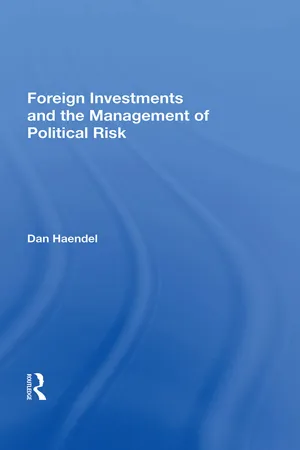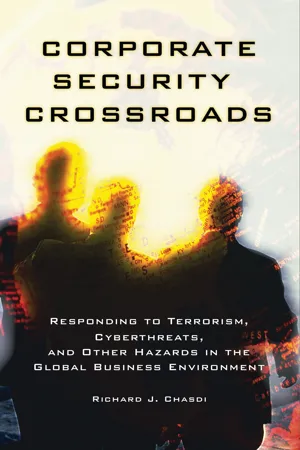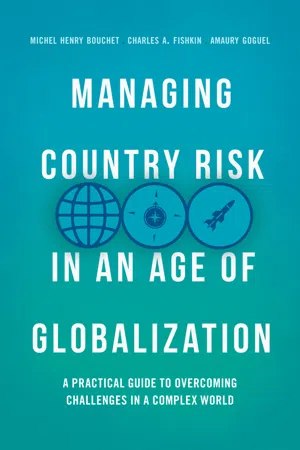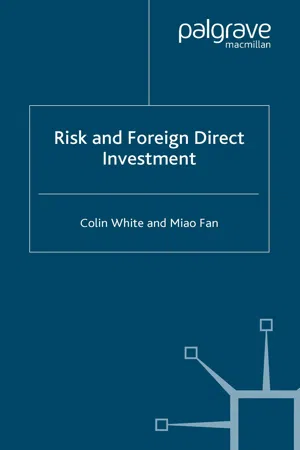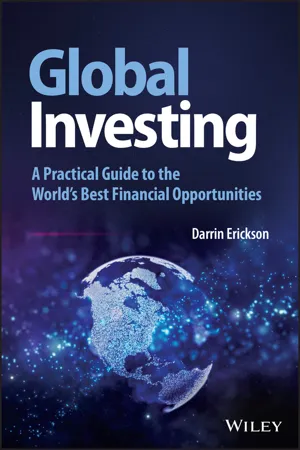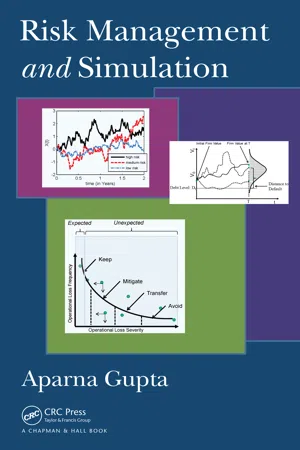Business
International Risk
International risk refers to the potential for adverse events or uncertainties that arise from engaging in business activities across national borders. These risks can include political instability, currency fluctuations, legal and regulatory differences, and cultural challenges. Businesses must carefully assess and manage international risks to protect their investments and operations in foreign markets.
Written by Perlego with AI-assistance
Related key terms
1 of 5
10 Key excerpts on "International Risk"
- Dan Haendel(Author)
- 2019(Publication Date)
- Taylor & Francis(Publisher)
3Political Risk: Identifying and Defining the IssueInternational corporate executives face governmental institutions and a variety of risks that distinguish their task from that of domestic corporate executives. Many view political risk in terms of government interference, through specific acts or events, with the conduct of business or in terms of overall government policy and attitude toward foreign investors. The international corporate executive is likely to view the international and host country environments as adding additional and difficult dimensions to the conduct of business operations. The increasing role of governments in the regulation of business justifies this perception.Identification and Assessment of “Political Risk”
A general awareness of the political risk problem has stimulated a variety of efforts to understand and deal with its complexity. For some, political risk is best illustrated by “politically caused” losses—for example: “(1) confiscation of property without adequate compensation, (2) damage to property or actions against personnel, (3) governmental interference with the terms of privately negotiated contracts, (4) bans on remittances of currency, and (5) discriminatory taxation or other arbitrary requirements on the firm.”1Others, however, may search for the fundamental cause of these losses and point to a factor such as political instability. Having isolated this factor, they may then focus on the familiar trilogy of various social, political, and economic factors as tending to cause instability: “(1) strong internal factions (religious, racial, language, tribal, or economic), (2) social unrest and disorder, (3) recent or impending independence, (4) new international alliances and relations with neighboring countries, (5) forthcoming elections, (6) extreme programmes, (7) vested interests of local business groups, and (8) proximity to armed conflict.”2- eBook - PDF
- Henk Jager, Catrinus Jepma(Authors)
- 2017(Publication Date)
- Red Globe Press(Publisher)
CHAPTER 15 International Risk: Types and Hedges 15.1 Introduction Business activities are associated with uncertainty and with the handling of risk. Even if the entrepreneur operates exclusively in her own country, she is subject to a variety of business risks. Prices may change, consumer tastes will vary, debtors may default, and laws can be altered. However, there are grounds for arguing that the internationalization of business trans-actions increases both the level and the variety of business risks. One reason is that risk that also exists for domestic business increases in the case of foreign business transactions. For example, since some customers are now located overseas, there is perhaps a greater risk of being caught out by defaulting debtors – in most cases a supplier has less information on foreign than on domestic customers. A second reason is that international transactions introduce new sources of risk – for example, exchange-rate risk, due to international trade, foreign production or international credit and loans. This chapter evaluates the effects on a company’s risk profile that arise as a result of the internationalization of its activities and addresses the following questions: ◦ What does internationalization add to existing risk types of a company? ◦ What typical types of risk do entrepreneurs have to consider when they go abroad? ◦ What instruments are available to reduce or eliminate these risks? In this chapter we shall use the term ‘company’ in its broadest sense: it can be applied to an industrial company, a financial business such as a commercial bank or an investment company. Section 15.2 reviews a large range of risks, such as credit or debtor risk and market risk in the case of purely domestic transactions, as well as country risk, political risk or sovereign risk, policy risk, transfer risk, exchange-rate risk, transaction risk, economic risk, and translation risk in the case of typical international business activities. - eBook - ePub
Corporate Security Crossroads
Responding to Terrorism, Cyberthreats, and Other Hazards in the Global Business Environment
- Richard J. Chasdi(Author)
- 2017(Publication Date)
- Praeger(Publisher)
5 In this book, the approach to risk is tied to the risk type Monahan calls “risk reduction,” where emphasis is placed on the reduction of explanatory factors and factor effects from a wide range of political, economic, and historical conditions found in particular operational environments and in the global environment.Monahan’s notion of “risk reduction” or “risk abatement” is different from “risk assessment,” with the latter producing specific probabilities about victimization risk, or the likelihood that people will pose a risk or potential risk to society.6 With Monahan’s notion of “risk reduction” in mind, one definition of “business security” as good as any is Spich and Grosse’s definition where, “business security can be defined as a defensive strategy and state of organizational readiness to assure and protect (but not guarantee) the functional integrity of the organization’s operational systems against purposeful, willful and intentional attempts by agents (inside or outside) to disrupt, damage, dismantle or destroy them.”7Although basic security concerns linked to multinational corporations are found in both the developed and the developing world, emphasis here is on multinational corporations primarily from the West and Japan, and increasingly China, that have offshore operations characterized by foreign direct investment in the developing world. That is the case because even though significant growth has occurred in multinational corporations from the emerging economies of Eastern Europe and the developing world, most multinational corporations still come from home countries in the developed world. It is those multinational corporations, primarily with their Western and Japanese executives, that are primarily vulnerable to political threats that derive from unresolved political problems. Kokaz-Muslu along with Jain and Grosse provide indications of the problem’s scope: Kokaz-Muslu asserts, “Approximately 80 percent of terrorist attacks against American interests over the past 30 years have been directed against American businesses.”8 Likewise, Jain and Grosse report, “Business should be concerned about terror-related risk, since 62% of terrorist attacks between 1999 and 2003 were targeted at businesses” (U.S. Department of State, 2003).9 - eBook - ePub
Managing Country Risk in an Age of Globalization
A Practical Guide to Overcoming Challenges in a Complex World
- Michel Henry Bouchet, Charles A. Fishkin, Amaury Goguel(Authors)
- 2018(Publication Date)
- Palgrave Macmillan(Publisher)
Model Risk : A Complex Challenge.)There are many other instances of uncertainty that can arise from a country’s political, economic, demographic, and cultural circumstances. They help illustrate the varied nature of Country Risk , as we explore further in Chapter 2 . For example:- Who will win the next leadership elections in Germany , France , and Italy ? What implications will these outcomes have for other countries in the Euro zone ?
- During the next year, which political regimes will falter or be subject to an attempted coup?
- What countries and cities will experience extreme weather conditions? What will be the impact on other countries and regions?
- Are there particular countries where the age of the population is changing faster than has been initially expected? If so, what are the consequences?
- What next technological innovation will fundamentally transform the way we work and live? In what country or countries will such innovation first emerge?
Box 1.1 Definitions of Risk
It is useful to examine how the term “risk ” has been used overtime by risk managers, risks advisors, regulators, and other practitioners. In some cases, these definitions limit the scope of risk to negative outcomes. In other cases, risk is also a source of opportunity.- International Organization for Standardization (ISO) : Risk is “the effect of uncertainty on objectives” (International Organization for Standardization 2009 ).
- Committee of Sponsoring Organizations of the Treadway Commission (COSO) :
- Risk is “the possibility that events will occur and affect the achievement of strategy and business objectives.”
- Uncertainty is “the state of not knowing how potential events may or may not manifest” (Committee of Sponsoring Organizations of the Treadway Commission 2017 ).
- Government of Australia : Risk is “the effect of uncertainty on objectives” where “an effect is a deviation from the expected, positive or negative” (Australian Government 2014 ). An enterprise framework developed for the US federal government uses a similar definition. See United States Chief Financial Officers Council and the Performance Improvement Council (2016 ).
- World Economic Forum : “A global risk is an uncertain event or condition that, if it occurs, can cause negative impact for several countries or industries within the next ten years” (World Economic Forum 2017
- eBook - PDF
- C. White, M. Fan(Authors)
- 2006(Publication Date)
- Palgrave Macmillan(Publisher)
146 The nature of country risk By far the most important risk context for FDI is the country environ- ment. This reflects the continuing importance of the nation state as the chief political unit in the world and the role of the government of such a nation state as a purposeful actor developing a strategy to achieve the objectives which give it legitimacy. It is easy in an era of so-called ‘globalisation’ to play down the role of national governments, but there is considerable evidence that the prime loyalty of many citi- zens is national and that governments continue to have much scope for pursuing independent policies of various kinds. Any government creates an environment of both opportunity and risk for an enterprise considering an investment project within its jurisdiction. Put simply, country risk is the unanticipated ‘downside’ variability in a key performance indicator, or significant strategic target, which results from engaging in international business transactions with an inevitable exposure to the performance and policies of a sovereign country other than the home country. It is, therefore, the risk which attaches to international business transactions as a consequence of the existence of national boundaries, i.e. separate countries, for example the consequent existence of separate currencies and separate sovereign- ties. One way to express this is that governments devise strategies in the context of which corporate strategies must be made. Inevitably government policies influence the enterprise and its performance, much more than the reverse is true. Country risk arises from the inter- action of strategies formulated and implemented by the relevant enter- prise and the relevant country government. This interaction occurs within a political, economic, financial and cultural context which is often alien to the foreign investor. The problem in the political area may be ignorance of what the host government is likely to do. - eBook - PDF
Corporate Financial risk management
A Practical Approach for Emerging Markets
- Scott Stanley(Author)
- 2019(Publication Date)
- Society Publishing(Publisher)
These risks or threats could originate from a broad range of sources, comprising financial uncertainty, legal liabilities, strategic management errors, accidents, and natural disasters. All the data related risks, IT security threats and the risk management strategies to lessen them, have become the main concern for digital companies. As a consequence, a risk management plan progressively comprises companies’ processes for identifying and controlling threats to its digital assets, including proprietary corporate data, a customer’s personally identifiable information, and intellectual property. 1.2. RISK: INTRODUCTION Risk suggests means uncertainty in future about deviation from projected income or projected result. Risk evaluates that an investor is ready to take to earn a profit from an investment. Risks are of various kinds and begin from various circumstances. Liquidity risk, insurance risk, business risk, sovereign risk, default risk, and so on. Different risks begin because of the uncertainty emerging out of different elements that impact an investment or a circumstance. The likelihood that a real return on an investment will be lower than the anticipated return (Figure 1.1). Financial risk is distinguished into the following classifications: • Basic risk; • Capital risk; • Country risk; • Default risk; • Delivery risk; • Economic risk; • Exchange rate risk; • Interest rate risk; The Evolution and Scope of Risk Management 3 • Liquidity risk; • Operations risk; • Payment framework risk; • Political risk; • Refinancing risk; • Reinvestment risk; • Settlement risk; • Sovereign risk; and • Underwriting risk. Figure 1.1: Different forms of financial risks. Source: https://wikifinancepedia.com/finance/financial-management/what-is-financial-risk-management-techniques-methods-types. 1.3. THE SCOPE OF RISK MANAGEMENT 1.3.1. Risk Appetite Most insurance agencies executing Enterprise Risk Management (ERM) programs have built up an ERM committee. - eBook - PDF
Global Investing
A Practical Guide to the World's Best Financial Opportunities
- Darrin Erickson(Author)
- 2022(Publication Date)
- Wiley(Publisher)
This chapter considers how competing national agendas and resulting geopolitical events can affect equity markets, and how investors can monitor and respond to them effectively. The severity of any given situation is dependent on the importance placed by each party on a particular issue, and the level of urgency for an outcome. Shared interests must also be consid- ered. Issues where the desired outcomes are incompatible and deemed vital to both parties have a greater probability of escalating than those not consid- ered vital to national interests, or where some common ground exists. C H A P T E R 7 RISKS OF INVESTING GLOBALLY 96 ■ ■ Types of Geopolitical Risk In this chapter we separate geopolitical risk into two broad types: internal risks and external risks. Internal geopolitical risks originate from an indi- vidual country while external geopolitical risks emanate from the interac- tions of two or more countries. Internal risks include regulation, changes to restrictions on foreign ownership, and changes to tax regimes or other laws that can impact the profitability of a given business or industry. External risks include diplomatic and economic sanctions, trade wars, and, in extreme situations, military conflicts. As discussed in Chapter 3, the global supply chain also poses risks for businesses, especially in cases where companies rely heavily on outsourcing. As businesses have sought to lower costs by moving production to (or sourcing components from) lower-cost regions of the world, they expose their business operations to foreign jurisdictions and possibly to risks associated with shipping bottlenecks. Supply chain relation- ships can be extremely complex and may not be fully disclosed by the com- pany, meaning that most investors will not fully comprehend the underlying risks. For example, you may invest in a company that has outsourced the production of a critical component from a firm in another country. - eBook - PDF
- Susanne Soederberg, Paul Zarembka(Authors)
- 2016(Publication Date)
- Emerald Group Publishing Limited(Publisher)
The annual study of the sources and solutions to global risks is published ahead of the invitation-only WEF’s Annual Meeting in Davos, Switzerland. The Global Risk Reports describe changes occurring in the global risks landscape and identify the global risks that could play a critical role in the upcoming year. These reports also explore the interconnectedness of risks, and consider how the strategies for the mitigation of global risks might be structured to deliver optimal results for the benefit of all. In assessing risks, the Global Risk Network draws a focus on workshops, interviews, and survey of international experts from the world’s largest insurance and re-insurance corporations, such as Swiss Re and Zurich Insurance Group. Other notable experts and professionals who identify and define the problems and solutions regarding global risks are drawn from a variety of powerful corporations and corporate-funded founda-tions that include: Bank of America, Barclays, Bill & Melinda Gates Foundation, BlackRock, Citi, Deutsche Bank, Goldman Sachs, Google, HSBC, JP Morgan, Marsh &McLennan Companies, MasterCard, Morgan Stanley, Prudential, Standard & Poor’s Rating Service, and Visa, and so forth ( WEF, 2006 ). Global risks À such as social instabilities, climate change, pandemics À are defined by the World Economic Forum (WEF) as uncertain conditions or events “that, if [they should occur], can cause significant negative impact for several countries or industries within the next 10 years” ( WEF, 2015 , p. 8). Moreover, the WEF suggests that global risks can be either economic or social, or both. According to the WEF Global Risk Report, for instance, an economic impact refers to an event that exceeds $10 billion, whereas a major social impact is defined in terms of human suffering and loss of life, triggering public pressure to respond ( WEF, 2006 ). - eBook - PDF
- Paul Sweeting(Author)
- 2017(Publication Date)
- Cambridge University Press(Publisher)
7 Definitions of Risk 7.1 Introduction When managing risks, it is important to be aware of the range of risks that an institution might face. The particular risks faced will differ from firm to firm, and new risks will develop over time. This means that no list of risks can be exhaustive. It is possible to describe the main categories of risk, and the ways in which these risks affect different types of organisation. However, even this is not without risks. Risks can be categorised in any number of different ways, and the definitions given below are not the only ‘right’ ones. It is more important that the taxonomy used in any institution is itself internally consistent, and that this taxonomy is widely understood and agreed within the institution. 7.2 Market and Economic Risk Market risk is the risk inherent from exposure to capital markets. This can relate directly to the financial instruments held on the assets side (equities, bonds and so on) and also to the effect of these changes to the valuation of liabilities (long-term interest rates and their effect on life insurance and pensions liabilities being an obvious example). Closely related to market risks are economic risks, such as price and salary inflation. Whilst these risks often affect different aspects of financial institutions – market risk tends to affect the assets and financial risk the liabilities – there is some overlap and both can be modelled in a similar way. Banks face market risk in particular in two main areas. The first is in relation to the marketable securities held by a bank, where a relatively straightforward asset model will suffice; however, this risk must be assessed in conjunction with market risk relating to positions in various complex instruments to which many banks are counter-parties. It is important both to include all of the positions but also to ensure - eBook - PDF
- Aparna Gupta(Author)
- 2016(Publication Date)
- CRC Press(Publisher)
This exposure can arise as a natural consequence of busi-ness operations, not necessarily due to explicitly taking a position in a cur-rency. It can have a pretty drastic impact on a firm by potentially sweeping away profits. It can place a firm at a competitive disadvantage, can generate huge operating losses, and in the end, inhibit growth and investment. Foreign exchange risk arises from an imperfect correlation between currency prices, international interest rates, and domestic interest rates. Commodity risk. The variability in price of raw materials that are cru-cial for the production economy constitute this risk. Price risk of commodi-ties behave differently from interest-rate and foreign exchange risk, because commodity prices are often controlled by few suppliers, which can magnify volatility. Fundamentals affecting commodity prices include market liquidity (or illiquidity), degree of ease, and level of cost of storage of the commodity. Due to these reasons, commodity prices have higher volatility and display sud-den large changes or jumps. Commodities can be classified into the following groups, based on some common shared properties. Hard (nonperishable): Precious metals (gold, silver, platinum), base met-als (copper, zinc, tin) Soft (perishable short shelf life and hard to store): Agricultural prod-ucts (grains, coffee, sugar, orange juice) Energy: Oil, gas, electricity Credit risk. When banks issue a loan, they expose themselves to the risk that either the interest or the principal itself may not be paid, or may not be paid on time. This is credit risk. While default is the extreme case (i.e., a counterparty is unable or unwilling to fulfill its obligation), credit risk also includes changes in the credit quality of a counterparty, since this affects the value of the loan or portfolio of loans. Institutions are also exposed to the risk that a counterparty, which may be another institution or a government, is downgraded by a rating agency.
Index pages curate the most relevant extracts from our library of academic textbooks. They’ve been created using an in-house natural language model (NLM), each adding context and meaning to key research topics.
